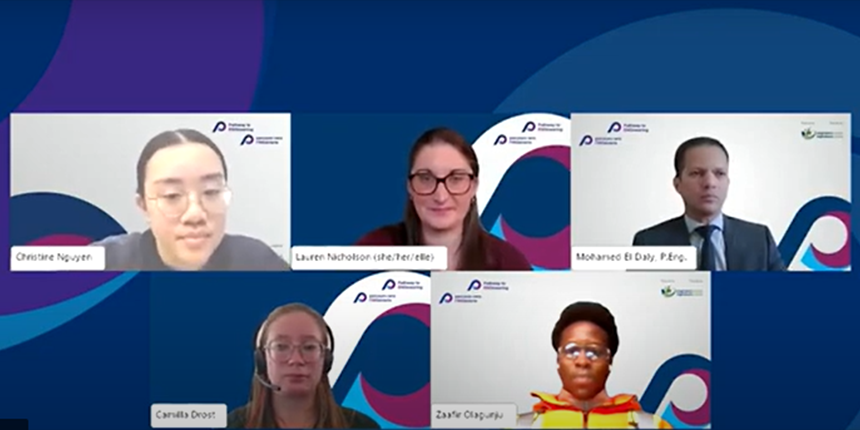

On October 24, Pathway to Engineering, Engineers Canada’s new platform to support recent engineering graduates, held the second Exchanges webinar: Prepare for the career ahead: regulator programs to help graduates gain licensure.
With an introduction by Engineers Canada and moderated by Christine Nguyen, National Councillor of the Canadian Federation of Engineering Students (CFES) and a final year Electrical Engineering Student at Toronto Metropolitan University (TMU), the webinar featured speakers from two regulators, the Association of Professional Engineers and Geoscientists Alberta (APEGA) and the Association of Professional Engineers and Geoscientists of New Brunswick (APEGNB), both of whom were discussing work programs offered to students and recent post graduates who are working to gain licensure, as well as two students, one from each of their respective programs.
The panellists were: Mohamed El Daly, P.Eng., Director of Outreach and Product Services at APEGA; Lauren Nicholson, Director of Communications at APEGNB; Zaafir Olagunju, a 5th year mechanical engineering student in APEGA's Work Readiness Program; and Camilla Drost, a final year chemical engineering student in APEGNB's Connections program.
The four panellists engaged in an informative discussion that began with an explanation of the programs offered by each regulator, the value of licensure and the role that these programs play in supporting students, and the lessons and experiences that each student has gained from participating in these programs.
El Daly discussed how APEGA’s Work Readiness Program focuses on skill building. “We look at the competencies that APEGA evaluate as you apply to become a registered professional engineer, and we turn these competencies into components that allow you to acquire knowledge and practice this skill. We take into account where you are in your journey to make sure that by the time you graduate and you're ready to put in your application, you are prepared to join the workforce fully competent and hit the road running.”
Nicohlson described how APEGNB’s Connections program really focuses on networking and knowledge sharing. “It's designed to bridge the gap between Members-in-Training and students and seasoned professionals across all engineering and geoscience disciplines. Mentees can choose their mentor based on specific competencies and interests, and it really ensures a personalized match. The program adapts to the unique needs of participants by offering flexibility in how and when they engage through one-on-one virtual meetings.”
Both regulator panellists stressed the importance of getting involved in programs like these or others offered by regulators in order to gain as much understanding and experience of the licensure process as possible to prepare students for the rigours of the process and the profession itself.
For Olagunju, the practical nature of APEGA’s program has proved to be the most useful aspect. “One of the main challenges I faced before joining the program was bridging the gap between theoretical knowledge from my engineering classes and practical applications of these theories. The transition from academia to industry can be daunting, especially in terms of understanding the expectations, responsibilities, and workplace dynamics.” For Olagunju, APEGA’s Work Readiness Program provides a clear framework and structure for him to follow, a roadmap to becoming a fully licensed engineer.
Drost echoed Olagunju, touching on how the mentors really helped outline what the licensure process would like and its importance for the profession. “They have also helped me consider decisions on what to do postgrad. The mentors have been really wonderful in supporting the decision process, not being biased one way or another, but really giving you the full facts, what their careers have looked like, how they've been able to use their skills, and things that they maybe wish they would have done or that they're really happy that they've done. So overall, it's been really, really supportive,” Drost said.
All four panellists took the time to answer questions about how these programs work and how to apply. They also spoke of the changes they hope to make and how they see programs like these evolving in the future to better meet student needs.
_____
This Exchanges webinar can be found on Pathway to Engineering. Email us with your ideas at connect@pathwaytoengineering.ca and connect with us on Instagram, LinkedIn, and Facebook. Tell us what topics you’d like us to dive into or which subjects you’d like to hear more about.
We’re incredibly excited to have you here and to begin growing this community with you.


